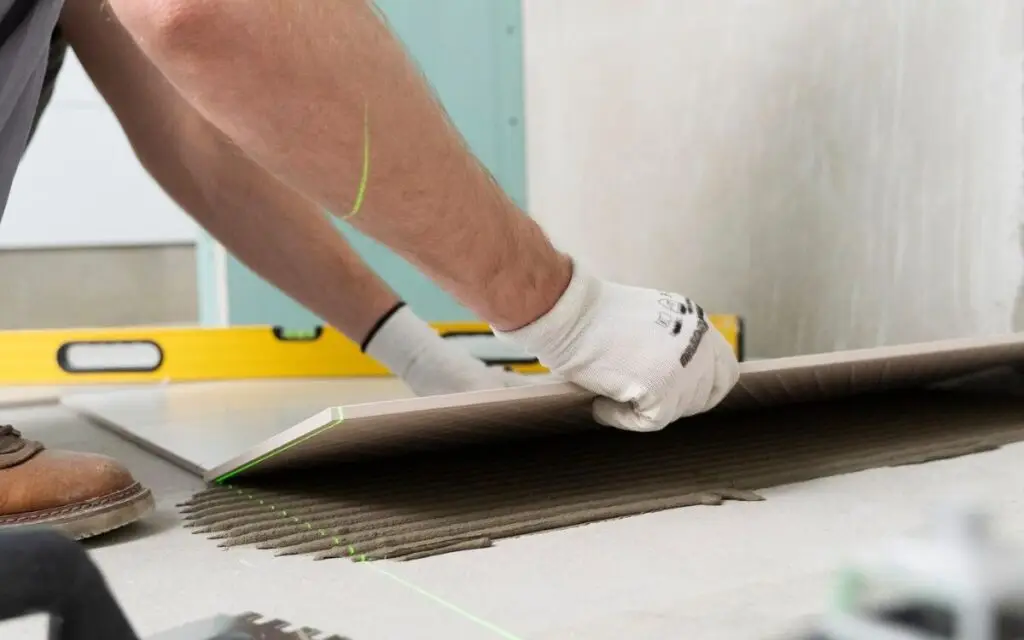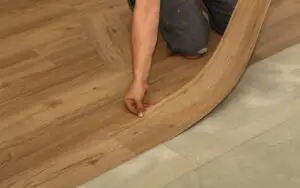Where to Start When Laying Tile: A Step-by-Step Guide
1. Planning and Preparation: The Foundation for Success
Laying tile can dramatically enhance the look and feel of any space, but a successful tile installation hinges on thorough planning and preparation. Jumping into the process without a clear roadmap can lead to costly mistakes and unsatisfactory results. So, where to start when laying tile? The answer is simple: with meticulous planning.
1.1. Defining the Scope of Your Project
Before you even think about tile installation tools or mortar selection, take a step back and define the scope of your project. What area are you tiling? Is it a small bathroom floor or a large kitchen backsplash? Clearly defining the scope helps you determine the amount of materials needed, the complexity of the job, and the overall budget. Don’t forget to factor in any existing fixtures or obstacles that might require special cuts or modifications. A professional can help you accurately assess the scope of your project, ensuring you’re not under or over-prepared.
1.2. Measuring the Area and Calculating Tile Needs
Accurate measurements are crucial for avoiding material shortages or surpluses. Use a reliable measuring tape and carefully measure the length and width of the area you’ll be tiling. Multiply these measurements to determine the total square footage. Then, add an extra 10-15% to account for cuts, waste, and potential breakage. This step is especially important if you’re using patterned tiles or intricate designs. Many homeowners make the mistake of underestimating the amount of tile needed, leading to delays and extra trips to the store. Professionals are adept at calculating tile installation needs, minimizing waste and ensuring a seamless installation.
1.3. Selecting the Right Tile for Your Project (Type, Size, Material)
The market offers a dizzying array of tile options, each with its own unique characteristics and suitability for different applications. Consider factors like durability, water resistance, slip resistance, and aesthetics. Ceramic and porcelain tiles are popular choices for their affordability and versatility, while natural stone tiles offer a luxurious and timeless appeal. Larger tiles can create a more modern and spacious look, while smaller tiles are ideal for intricate patterns and designs. When considering tile installation bathroom, keep water resistance in mind. Don’t know where to start when laying tile in terms of selection? A professional installer can guide you through the selection process, helping you choose the perfect tile type, size, and material for your specific needs and preferences.
1.4. Budgeting for Your Tile Installation
Tile installation can be a significant investment, so it’s essential to establish a realistic budget upfront. Factor in the cost of tiles, mortar, grout, tools, and any necessary subfloor preparation. If you’re hiring a professional installer, be sure to get a detailed quote that includes labor costs and any potential additional charges. It’s always wise to allocate a contingency fund for unexpected expenses or unforeseen issues that may arise during the tile installation process.
2. Essential Tools and Materials for Tile Installation
Having the right tools and materials on hand is essential for a smooth and efficient tile installation. Attempting to cut corners or use substandard materials can compromise the quality and longevity of your finished project.
2.1. Must-Have Tools for Cutting and Setting Tile
Tile Cutter: For making straight cuts in ceramic and porcelain tiles.
Wet Saw: For cutting larger tiles, natural stone tiles, and intricate shapes.
Notch Trowel: For applying mortar evenly and creating ridges for tile adhesion.
Rubber Grout Float: For applying grout smoothly and evenly between tiles.
Grout Sponge: For cleaning excess grout from the tile surface.
Level: For ensuring a flat and even tile surface.
Spacers: For maintaining consistent spacing between tiles.
These tile installation tools are essential for doing the job correctly.
2.2. Choosing the Right Mortar and Grout
Mortar and grout are the unsung heroes of tile installation, providing the necessary adhesion and sealing to ensure a long-lasting and water-resistant finish. Choose a mortar that is specifically designed for the type of tile you’re using and the substrate you’re installing over. Similarly, select a grout that is appropriate for the tile size, joint width, and exposure to moisture. Epoxy grouts are particularly durable and stain-resistant, making them a popular choice for high-traffic areas and wet environments.
2.3. Safety Gear: Protecting Yourself During Installation
Tile installation can involve working with sharp tools, power equipment, and potentially hazardous materials. Protect yourself by wearing safety glasses, gloves, and a dust mask. Knee pads are also a good idea for prolonged periods of kneeling. If you’re using a wet saw, be sure to wear ear protection and follow all safety guidelines.
2.4. Other Essential Materials: Spacers, Sealants, etc.
Tile Spacers: Ensure consistent spacing between tiles for a professional look.
Tile Sealant: Protects porous tiles and grout from stains and moisture.
Caulk: Seals gaps and joints around fixtures and edges.
Thin-Set Mortar: Bonds tiles to the subfloor.
3. Preparing the Subfloor: Ensuring a Solid Foundation
The subfloor is the foundation upon which your tile installation rests. A properly prepared subfloor is essential for preventing cracks, unevenness, and other problems that can compromise the integrity of your tile work.
3.1. Inspecting and Repairing the Subfloor
Carefully inspect the subfloor for any signs of damage, such as cracks, rot, or water stains. Repair any imperfections before proceeding with the tile installation. Fill cracks with patching compound, replace rotted wood, and address any underlying moisture issues.
3.2. Cleaning and Leveling the Subfloor
Thoroughly clean the subfloor to remove any dirt, debris, or adhesive residue. Use a scraper to remove any bumps or ridges, and fill any low spots with self-leveling compound. The subfloor should be perfectly clean, smooth, and level before you start laying tile.
3.3. Applying Underlayment for Added Protection
Underlayment provides an extra layer of protection for your tile installation, helping to prevent cracks and reduce noise transmission. Cement board is a popular choice for its durability and water resistance, while plywood underlayment can be used in dry areas.
3.4. Addressing Moisture Issues Before Tiling
Moisture is the enemy of tile installation. Before you begin tiling, be sure to address any underlying moisture issues, such as leaks or condensation. Install a vapor barrier to prevent moisture from seeping up from the subfloor.
4. Layout and Design: Creating Your Tile Pattern
The layout and design of your tile installation can have a significant impact on the overall look and feel of your space. Take the time to plan your layout carefully, considering factors like tile size, pattern, and focal points.
4.1. Determining the Focal Point and Starting Point
Identify the focal point of your room, such as a fireplace, window, or doorway. This will help you determine the best starting point for your tile installation. Ideally, you want to start in an area that is most visible and work your way outwards.
4.2. Dry-Fitting Tiles to Visualize the Layout
Before you start applying mortar, dry-fit the tiles to visualize the layout and ensure that everything fits properly. This will give you a chance to make any necessary adjustments and avoid costly mistakes.
4.3. Creating a Balanced and Aesthetically Pleasing Design
Strive for a balanced and aesthetically pleasing design that complements the style of your room. Consider using different tile sizes, colors, or patterns to create visual interest.
4.4. Planning for Cuts and Trimming
Plan for any necessary cuts and trimming in advance. Use a tile cutter or wet saw to make precise cuts, and be sure to leave enough room for grout lines.
5. Cutting Tiles: Achieving Precision and Accuracy
Cutting tiles is an essential part of the tile installation process, and it requires precision and accuracy. Using the right tools and techniques can help you achieve professional-looking results.
5.1. Choosing the Right Tile Cutter for Your Tile Type
The type of tile cutter you use will depend on the type of tile you’re cutting. A snap cutter is suitable for cutting ceramic and porcelain tiles, while a wet saw is necessary for cutting larger tiles, natural stone tiles, and intricate shapes.
5.2. Measuring and Marking Tiles for Cutting
Carefully measure and mark the tiles before cutting. Use a straight edge and a pencil to draw a precise cutting line.
5.3. Techniques for Cutting Straight Lines, Curves, and Angles
Straight Lines: Use a snap cutter or wet saw to cut straight lines.
Curves: Use a wet saw with a diamond blade to cut curves.
Angles: Use a miter saw or angle grinder to cut angles.
5.4. Safety Tips for Cutting Tiles
Always wear safety glasses and ear protection when cutting tiles. Use caution when handling sharp tools and power equipment.
6. Setting Tiles: Applying Mortar and Placing Tiles
Setting tiles involves applying mortar to the subfloor and carefully placing the tiles in position. This process requires patience and attention to detail to ensure a flat and even tile surface.
6.1. Mixing Mortar to the Right Consistency
Mix the mortar according to the manufacturer’s instructions. The mortar should be the consistency of peanut butter, not too wet and not too dry.
6.2. Applying Mortar Evenly and Efficiently
Use a notched trowel to apply the mortar evenly to the subfloor. Hold the trowel at a 45-degree angle to create ridges in the mortar.
6.3. Placing Tiles with Proper Spacing and Alignment
Carefully place the tiles on the mortar, using spacers to maintain consistent spacing. Gently press the tiles into the mortar to ensure good adhesion.
6.4. Using a Level to Ensure a Flat and Even Surface
Use a level to check the flatness of the tile surface. Make any necessary adjustments to ensure that the tiles are level and even.
7. Grouting and Sealing: Completing the Tile Installation
Grouting and sealing are the final steps in the tile installation process. Grouting fills the gaps between the tiles, providing a water-resistant and aesthetically pleasing finish. Sealing protects the grout from stains and moisture.
7.1. Choosing the Right Grout for Your Tile
Choose a grout that is appropriate for the tile size, joint width, and exposure to moisture. Epoxy grouts are particularly durable and stain-resistant, making them a popular choice for high-traffic areas and wet environments.
7.2. Applying Grout Evenly and Thoroughly
Use a grout float to apply the grout evenly and thoroughly between the tiles. Work the grout into the joints, ensuring that they are completely filled.
7.3. Cleaning Excess Grout and Polishing the Tiles
After the grout has dried slightly, use a grout sponge to clean excess grout from the tile surface. Rinse the sponge frequently with clean water. Once the grout is completely dry, polish the tiles with a soft cloth.
7.4. Sealing the Grout to Protect Against Stains and Moisture
Apply a grout sealant to protect the grout from stains and moisture. Follow the manufacturer’s instructions for application and drying time.
8. Common Mistakes to Avoid During Tile Installation
Even experienced DIYers can make mistakes during tile installation. Here are some common pitfalls to avoid:
8.1. Incorrect Subfloor Preparation
Failing to properly prepare the subfloor is one of the most common mistakes in tile installation. An uneven or unstable subfloor can lead to cracked tiles and other problems.
8.2. Using the Wrong Mortar or Grout
Using the wrong mortar or grout can compromise the adhesion and water resistance of your tile installation. Always choose materials that are specifically designed for the type of tile you’re using and the conditions of your environment.
8.3. Uneven Tile Spacing and Alignment
Uneven tile spacing and alignment can detract from the overall appearance of your tile installation. Use spacers to maintain consistent spacing and check the alignment of the tiles frequently.
8.4. Neglecting to Seal the Grout
Neglecting to seal the grout can leave it vulnerable to stains and moisture damage. Always seal the grout to protect your tile installation and keep it looking its best.
9. Maintenance and Care: Keeping Your Tiles Looking Their Best
Proper maintenance and care are essential for preserving the beauty and longevity of your tile installation.
9.1. Regular Cleaning and Maintenance Tips
Sweep or vacuum the tiles regularly to remove dirt and debris.
Mop the tiles with a mild detergent and water.
Avoid using abrasive cleaners or scouring pads, which can scratch the tile surface.
9.2. Protecting Tiles from Scratches and Stains
Use rugs or mats to protect tiles in high-traffic areas.
Clean up spills immediately to prevent staining.
Avoid using harsh chemicals or solvents on the tile surface.
9.3. Addressing Cracks and Damage Promptly
Repair any cracks or damage to the tiles promptly to prevent further deterioration.
9.4. Choosing the Right Cleaning Products
Choose cleaning products that are specifically designed for your type of tile. Avoid using acidic or alkaline cleaners, which can damage the tile surface.
10. DIY vs. Professional Tile Installation: Weighing the Options
While DIY tile installation may seem like a cost-effective option, it’s important to weigh the pros and cons carefully before deciding whether to tackle the project yourself or hire a professional. Knowing where to start when laying tile is only one part of the equation.
10.1. Cost Analysis: DIY vs. Professional
DIY tile installation can save you money on labor costs, but it can also lead to increased expenses if you make mistakes or damage materials. Professional installation may be more expensive upfront, but it can save you money in the long run by ensuring a high-quality, durable installation that will last for years to come.
10.2. Time Commitment and Skill Requirements
DIY tile installation requires a significant time commitment and a certain level of skill and experience. If you’re not comfortable working with tools, cutting tiles, and applying mortar, it’s best to leave the job to a professional.
10.3. Potential Risks and Liabilities of DIY Installation
DIY tile installation can involve potential risks and liabilities, such as injuries from using power tools or damage to your property. If you’re not properly insured, you could be held liable for any accidents or damages that occur during the project.
10.4. Benefits of Hiring a Professional Tile Installer: Expertise, Warranty, and Peace of Mind
Hiring a professional tile installer offers numerous benefits, including:
Expertise: Professional installers have the knowledge and experience to ensure a high-quality, durable installation.
Warranty: Many professional installers offer warranties on their work, providing peace of mind in case of any problems.
Peace of Mind: Knowing that your tile installation is in the hands of a skilled professional can give you peace of mind and allow you to enjoy your new tile for years to come.
10.5. Case studies: Examples of failed DIY tile installtions
Many homeowners try to save money by attempting DIY tile installation, only to encounter costly and frustrating problems. One common scenario involves inadequate subfloor preparation. For example, a homeowner in [Any city/state] attempted to install tile directly over a slightly uneven plywood subfloor in their bathroom. Over time, the tiles began to crack and loosen due to the lack of proper support. They ended up spending more money to hire a professional to remove the damaged tile, repair the subfloor, and reinstall the tile correctly.
Another common issue arises with incorrect mortar mixing and application. A homeowner in [Any city/state], followed a YouTube tutorial to install a tile backsplash in their kitchen. However, they didn’t achieve the right mortar consistency, resulting in poor adhesion and tiles that started falling off the wall within a few weeks. They learned the hard way that proper mortar mixing requires experience and precision.
These are just a couple of examples of how a “simple” DIY tile installation project can quickly turn into a nightmare. By hiring a professional, you can avoid these costly mistakes and ensure a beautiful and long-lasting tile installation. Get a free quote today and avoid the headaches of DIY!
FAQs & Answers
Selecting the right tile involves several considerations. You'll need to factor in the location (bathroom, kitchen, floor, wall), the amount of foot traffic, moisture levels, and your desired aesthetic. Different materials like ceramic, porcelain, and natural stone have varying properties in terms of durability, water resistance, and maintenance. Making the wrong choice can lead to tiles cracking, staining, or requiring frequent repairs. A professional tile installer can guide you through the selection process, ensuring you choose a tile that meets your specific needs and budget while providing long-lasting beauty and functionality. Their experience ensures you avoid costly mistakes and get the perfect tile for your space.
While it's tempting to save time and effort by installing tile directly over an existing floor, it's generally not recommended without proper preparation. The existing floor needs to be perfectly level, stable, and free from any loose debris or coatings. Unevenness or instability can cause the new tiles to crack or become unbonded over time. Additionally, you need to consider the added height, which may interfere with doors and transitions to other rooms. Professionals will assess your existing floor, make necessary repairs or leveling, and apply the appropriate underlayment to ensure a solid and long-lasting foundation for your new tile. This is important as the floor can have deflection with people walking on it, which could cause the tiles to crack if not properly installed.
Sealing the grout is a crucial step in tile installation that is often overlooked by DIYers. Grout is porous and highly susceptible to staining, dirt, and moisture penetration. Without sealing, your grout can quickly become discolored, harbor bacteria, and even crumble over time. Sealing creates a protective barrier that prevents these issues, keeping your tile looking clean and new for longer. Professional tile installers use high-quality sealants and apply them correctly to ensure maximum protection. They also understand the different types of sealants available and can recommend the best one for your specific tile and grout type.
While DIY tile installation might seem like a cost-effective option, it comes with a significant amount of risks. From improper subfloor preparation to incorrect mortar mixing and uneven tile placement, mistakes can lead to a range of problems, including cracked tiles, water damage, and costly repairs. Additionally, working with power tools and sharp materials can pose safety hazards for inexperienced individuals. Hiring a professional tile installer minimizes these risks. They have the expertise, tools, and experience to ensure a flawless installation that meets industry standards and provides long-lasting results.
The cost of professional tile installation varies depending on several factors, including the size of the area, the type of tile, the complexity of the design, and the condition of the subfloor. While it may seem more expensive upfront compared to DIY, it's important to consider the long-term value and potential cost savings. Professional installers provide warranties on their work, ensuring that any issues are promptly addressed. Additionally, their expertise minimizes the risk of costly mistakes and ensures a high-quality, durable installation that will last for years to come. Contact us for a free, no-obligation quote and discover the true value of professional tile installation.





